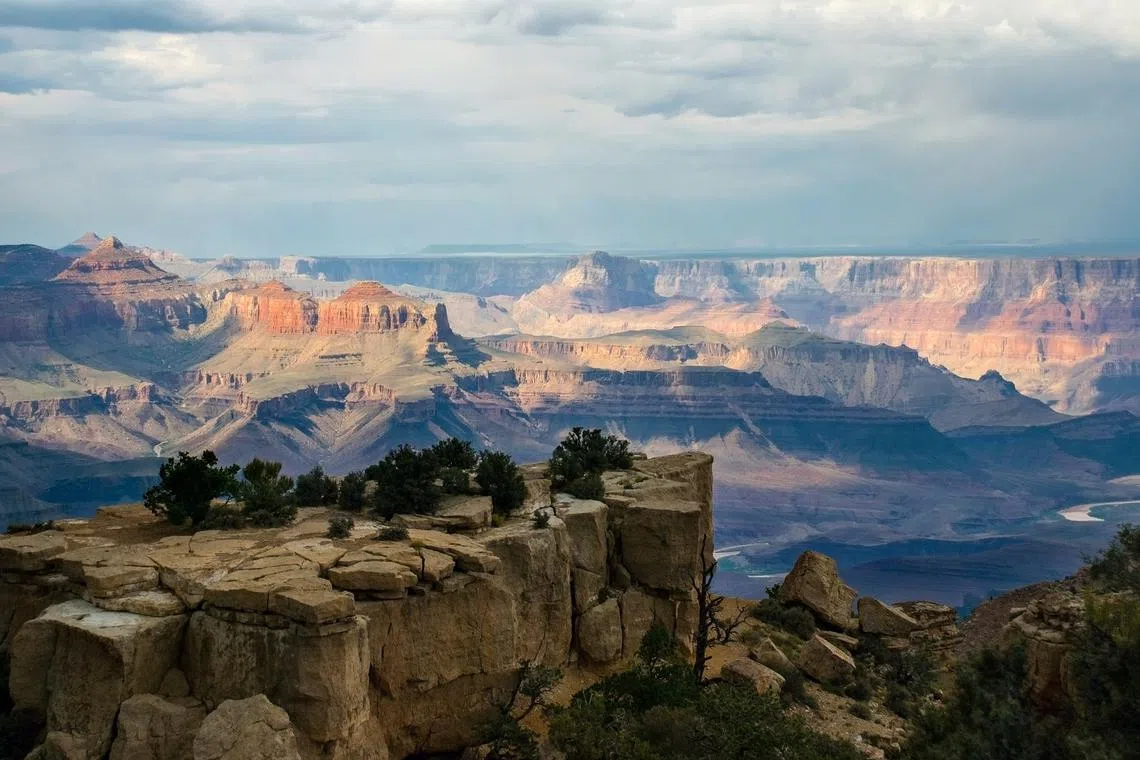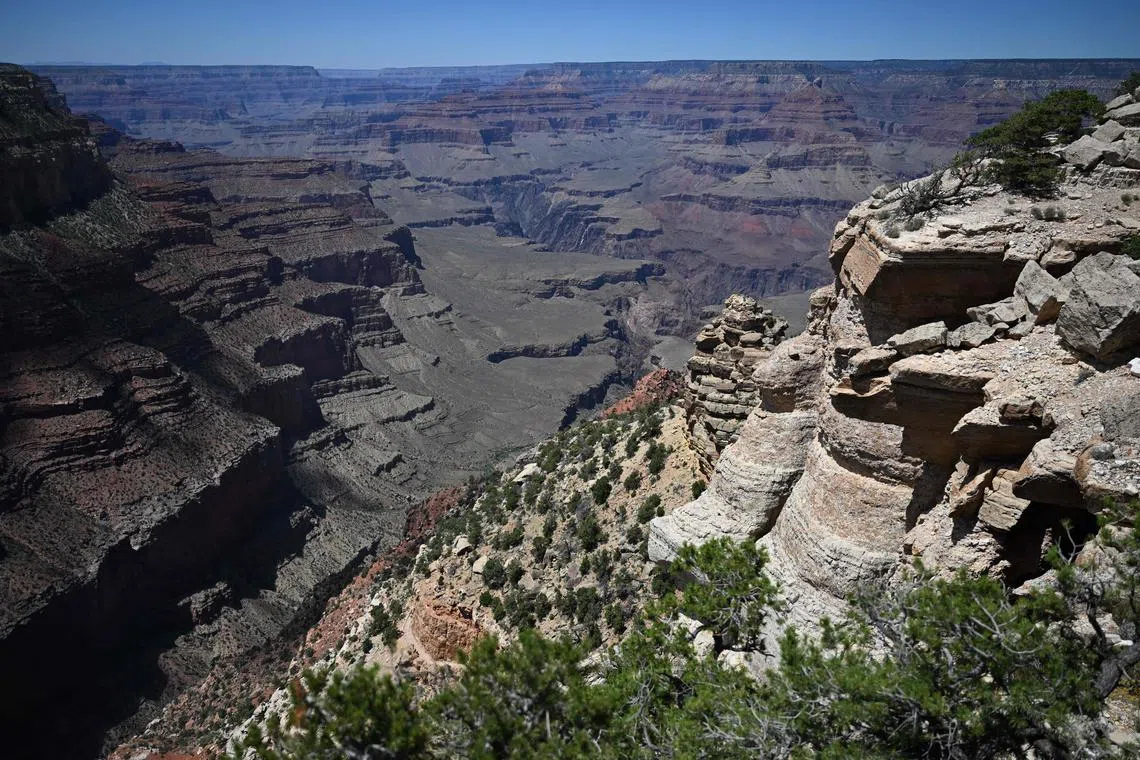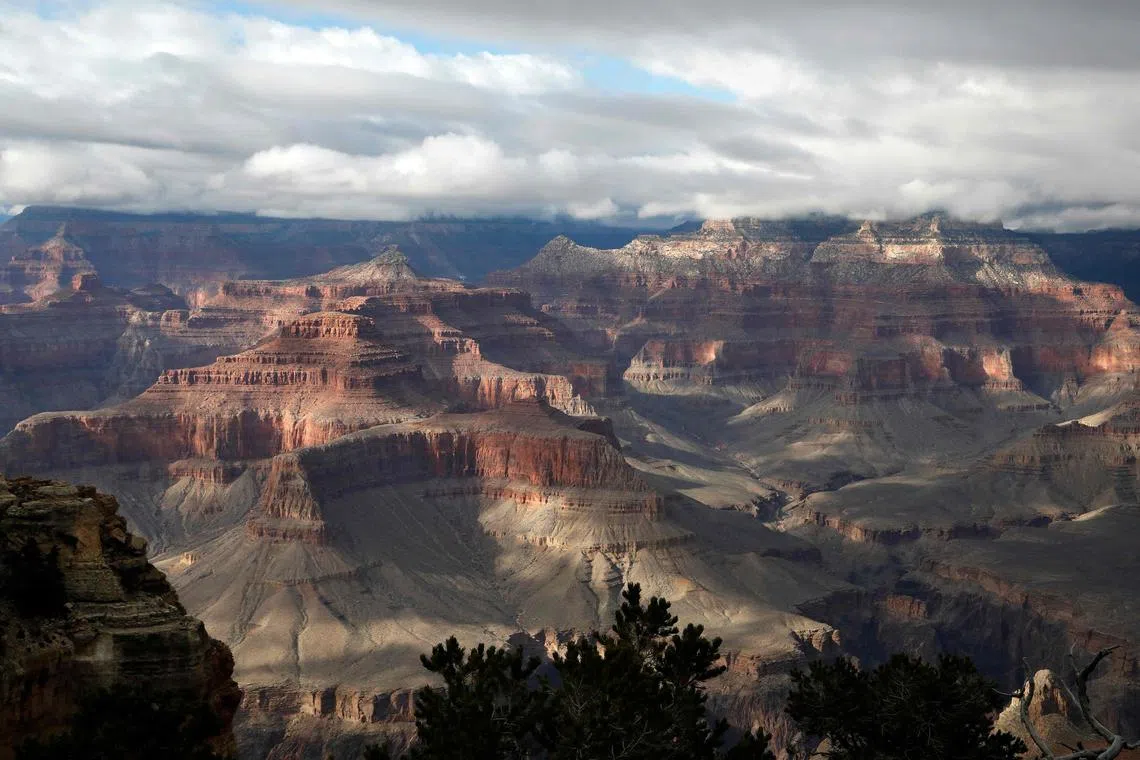Saving lives at the scorching Grand Canyon with salty ramen and aggressive messaging
Sign up now: Get ST's newsletters delivered to your inbox

The Grand Canyon in the United States is a popular destination among travellers, but the increasingly hot weather has proven to be challenging for hikers.
PHOTO: UNSPLASH
Rowan Moore Gerety
Follow topic:
ARIZONA – Watching weary day hikers start the long uphill hike from Phantom Ranch, a ranger station at the bottom of the Grand Canyon, Mr Jeff Schwartz has learnt to look for telltale warning signs.
“They’ve got the salt stains all over their shirt, and clearly have a day pack on, and you’re like, ‘let’s prevent some search and rescue by talking with these folks’,” said Mr Schwartz, a paramedic and backcountry park ranger who has worked at Grand Canyon National Park since 2012.
After a dozen summers on the trail, he also knows what to offer: a comfortable seat in the shade of the ranger’s office, and maybe something salty to eat. “It’s amazing what a bowl of ramen noodle soup will do,” he said.
An unplanned overnight at the ranch may be in order for those in truly dire straits.
For everyone else, the ramen is a reset, a dish served with a frank discussion about how long and how hard it might be to get back to the rim.
It has been a deadly summer for hikers in America’s south-west.
At least seven have died in recent weeks from apparent heat-related causes – including one at the Grand Canyon, one in Death Valley
The Grand Canyon’s search-and-rescue staff are among the busiest in the entire park system, with an average of more than 300 incidents a year and tens of thousands of “visitor contacts” meant to head off even more emergencies.
But while search-and-rescue incidents across the national park system have ticked upwards alongside rising visitation in recent years – a post-pandemic rebound in annual visits this year is climbing towards the 2016 record of 330 million – that is not the case at the scorching Grand Canyon.
There, in recent years, staffing and aggressive messaging focused on preventing heat-related illness have helped to uncouple the number of visitors from the number of search-and-rescue incidents, a number that has dropped from the 1996 peak of 482, even as visitors have increased.
Inverse mountain
In 2022, the National Park Service tallied 3,428 search-and-rescue incidents – incidents that might include helicopter flights and multi-day searches, and can cost tens of thousands of dollars.
According to Professor Travis Heggie from Bowling Green State University, a former public risk management specialist for the National Park Service, that number is a significant undercount: It does not include so-called “agency assists”, or search-and-rescue responses by entities like sheriff’s offices, which are often better positioned to respond in some remote areas.
If those, too, figured in National Parks statistics, he said, “the total would probably increase by about 30 per cent”.

Staff often refer to the canyon as an “inverse mountain”, where you start your hike with a long, vista-filled downhill, and the mercury rises as the elevation drops.
PHOTO: AFP
Although the Internet has made it easier to do research before hitting the outdoors, the hurricane of information available has not necessarily led to better-prepared visitors.
One common and frustratingly lasting misconception in the Grand Canyon: that it gets cooler as you hike down.
Staff often refer to the canyon as an “inverse mountain”, where you start your hike with a long, vista-filled downhill, and the mercury rises as the elevation drops.
There is no question climate change is contributing to the increase in incidents, Mr Schwartz said.
“When it’s sunny and over 95 deg F in the canyon, our call volume for emergency medical response and rescue goes way up,” he said. The 95 deg F temperature is about 35 deg C.
During this historically hot July, at the halfway point between the rim and canyon bottom, not a single day has passed with a high temperature below 35 deg C.
At Phantom Ranch, there have been nights when the low temperature has not dipped below 32 deg C.
Pioneering a new strategy
Mr Schwartz supervises rangers who work eight days on, six days off, and cycle between three ranger stations in the canyon and living out of backpacks on trail patrols. The team is, he said, “down there for whatever comes up”.
On the so-called “SAR shift”, for search-and-rescue, Mr Schwartz stays mobile, driving around the South Rim and taking cellphone calls to dispatch everything from Chex Mix snacks for hikers to medevac helicopters wherever they are needed.
On a hot day in June, a boater was flown out of the canyon with a lower-body injury. Now, in the heat of the afternoon, several day hikers were unexpectedly spending the night at Phantom Ranch – a near daily occurrence in the summer.
“These are folks who are missing out on their hotel rooms, missing out on their flights home,” Mr Schwartz said of the hikers he typically helps at Phantom Ranch.
“They thought they’d be fine – they’ll be exhausted, maybe they’ll have muscle cramps, they’ll have to drag themselves out. But they’re really not picturing hours of uncontrollable vomiting or renal failure.”
The range of possibilities extends to permanent disability and death. “Those are the things that we’re worried about when we’re talking to people down there.”
The salty snacks offered by rangers are part of an approach known as P-SAR, or “preventive search and rescue”, pioneered here after an extreme heat wave in 1996 led to hundreds of cases of heat exhaustion and five fatalities.
“We had non-stop calls,” recalled Mr Ken Philips, who led the park’s search and rescue at the time. “It got to a point where we were like zombies.”
Something had to change. Now, park staff and volunteers undertake P-SAR training, and are told that the goal is to “get everyone back out of the canyon alive”.
Also, said the P-SAR coordinator, Ms Meghan Smith, the aim is to help people avoid experiences that will make them reluctant to return.
While only a handful of parks have dedicated P-SAR staff like that of the Grand Canyon, the approach is drawing interest: This year, a P-SAR symposium at the park hosted staff from 31 other park sites.
Dozens of new P-SAR positions across the system are expected to come online soon.
No longer about just drinking water
In June, several seasonal and full-time employees were supplementing their weekly half-day of training with a multi-day course focused on serious rescues.
As they practised rappelling down the canyon walls and manoeuvring loaded stretchers back up over the rim, tourists passing by pointed and stared.
Staff in harnesses and helmets ringed with broad-brimmed lids – “SARbreros” – called out to be raised and lowered down the cliff-side a few feet at a time, their ropes secured to a craggy pinyon pine. A motorised rope winch whined like out-of-tune bagpipes. Radios crackled.
Trainer and emergency medical services coordinator James Thompson explained the evolution of the park’s approach since the advent of P-SAR in the late 1990s, when the core message to hot weather visitors was “drink, drink, drink”.
“That pushed people into becoming hyponatremic, where they lose a bunch of salt, but they can’t regain it,” he said, a situation that can lead to dangerous brain swelling and seizures.
If hikers readily absorbed the message that they needed to hydrate at all costs, they often forgot the corollary: sweating through the dry heat robs your body not just of fluids, but of the sodium that is essential to muscle and nerve function.

Visitors to the Grand Canyon are being reminded that besides remaining hydrated, they also need to replace the salt their bodies are losing.
PHOTO: AFP
The park has since altered its public messaging and deployed blood testing machines called I-STATs, usually reserved for use in hospitals, in the backcountry. The machines allow rangers to diagnose hyponatremia on the spot and administer IVs with a highly concentrated saline solution.
One morning in June, I got on the crowded Bright Angel trail myself. Through the thin high desert atmosphere, the sun was not shining so much as pinning other hikers and me to the canyon walls.
Our descent was marked by geologic eras – Kaibab limestone, the Toroweap formation, Coconino sandstone.
I had fancied myself the type to try for the almost 28km round-trip jaunt, until the park’s press liaison, Ms Joelle Baird, told me, straight-faced, that I should leave by midnight, and certainly no later than 2am.
She spent her first years at the park as a P-SAR ranger, patrolling the upper reaches of trails into the canyon to offer hikers a friendly reality check. “I always look at the footwear,” she said, as in, “‘Oh, you are in flip-flops!’”
Halfway to the halfway point, I met a backcountry ranger practising P-SAR the whole way up the canyon.
Ms Betsy Aurnou, climbing with wraparound shades and fabric completely covering her face, carried Fritos and Vitalyte, and referred to the occasional slivers of shadow beneath overhung cliffs as “shade opportunities”.
I had fallen in rhythm alongside two young men from Broward County, Florida, with tiny water bottles and no hats.
Ms Aurnou gave us a cheery greeting before she got down to business – how far were we planning on going? Would anyone like any salty snacks?
She had already helped a trio of heat-exhausted siblings to find their way to Bright Angel Creek.
“They stayed in the creek for about 40 minutes, and then they hiked out and they were great,” she said, adding that we, too, should get soaking wet at the first opportunity.
Down at Havasupai Gardens, a stopover at the 7km mark and halfway to the river, I took her advice and lay in the creek with my shorts on, then dunked my hat and shirt for good measure. Signs also reminded hikers: “Your shirt is thirsty too.”
On the way back up, about 2.4km and 280 million years from the rim, I crossed paths with a couple I had seen that morning at a shaded pavilion.
Now, four hours later, they were in the same spot, still lingering in the shade before climbing the last stretch of the trail.
I could not help but think of the old bumper stickers the park had printed for the search-and-rescue team. “Down is optional,” they read. “Up is mandatory.” NYTIMES

